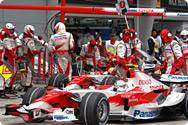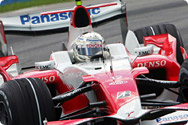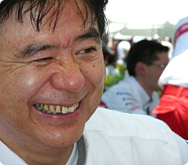Grand Prix > 2007 Grand Prix > Grand Prix of Malaysia > Review
|
|
10 April,2007 (Tue)
Thank you for your dedicated support of Panasonic Toyota Racing. Here is my report from the scorching hot Sepang International Circuit, home of the Malaysian Grand Prix.
Looking for improved aerodynamics, reduced drag
We bought an improved aerodynamic package to the joint testing session at Sepang, held the week prior to the grand prix race. Specifically, we reduced the number of roll hoop wings located near the induction pod by one pair, going from 2 pairs (two left, two right), to one set (two total). Last year we maxed out downforce due to troubles getting heat into the tires. This year, we don't have that problem, so our main goal is to reduce excess air resistance.
During the last stint at the Australian Grand Prix, Ralf (Schumacher) developed trouble with a drop in pneumatic pressure in the engine. Looking at the problem after the race, we determined that the issue was not with the engine itself, so we made what changes we could under the rules allowed by the FIA, and planned to race at Malaysia having both Ralf and Jarno (Trulli) run the same engines that completed the Australian Grand Prix.
Wandering through a maze of settings during Friday free practice
In a word, Friday was unsatisfying. I do not say that because Jarno finished only 16th on the time charts. In fact, the only reason Jarno was 16 was that he was caught behind traffic during his attack lap. Jarno's position wasn't what had us concerned. Rather, we were dissatisfied with our inability to find the right setup for our cars.
Owing partly to the fact that we had just completed tests the week prior to the race, Friday morning's free practice program progressed smoothly. But during the afternoon practice, both Ralf and Jarno suddenly developed severe issues with lack of grip. The cars lacked stability in the corners, with literally all four tires slipping. We were not overly surprised, since we have encountered this type of problem before. Our concern was that, no matter what we tried, we couldn't find a clear answer for our setup.
Normally, if we make a change that results in improvement, we can move more in that direction. Alternately, when a change makes things worse, we can expect a change in the opposite direction to have the desired effect. Unfortunately, every change we made on Friday had both advantages and disadvantages, resulting in much wasted time.
Having said that, we did come away from the session with a good number of laps and no trouble with either car. We were able to compare the two types of tires, confirming that they had the same characteristics and trends that we noted during testing a week earlier. While we couldn't find our answer during the session, we did collect a good amount of data, which we planned to go over in fine detail to determine what direction we needed to go for Saturday.
A misread of the weather; but we confirmed we were fast enough for a top six position in qualifying
Having looked at the data, we concluded that the problem that caused us such a headache on Friday was mainly the change in the track surface condition during the afternoon. Accordingly, we went to work Saturday morning without making any big settings changes.
 At this race, the softer sets of tires were marked with a white band. This photograph is from qualifying, where Ralf and Jarno both made their attack laps on the medium tires.
At this race, the softer sets of tires were marked with a white band. This photograph is from qualifying, where Ralf and Jarno both made their attack laps on the medium tires.During the session, Jarno never rose higher than 20th on the time charts, but this was due to the fact that his car developed electrical system troubles, and he was unable to put on the softer tires (medium type) to run an attack lap in advance of qualifying. With Ralf, we still couldn't find the right setting to produce a stable feel for his car on the harder tires. But since Ralf's setup was fine on medium tires, we believed he would perform well during qualifying.
 During testing prior to the GP, Panasonic Toyota Racing adopted a single set specification for roll hoop wings. While downforce is lost, the resulting benefits in reduced air resistance led the team to the decision to use the same spec for the race.
During testing prior to the GP, Panasonic Toyota Racing adopted a single set specification for roll hoop wings. While downforce is lost, the resulting benefits in reduced air resistance led the team to the decision to use the same spec for the race.As with the Australian GP, we checked out the cars using the harder tires during the first part of the first qualifying period, and then ran our attack laps using the medium compound tire. We used the medium tire for both parts of the second qualifying period, which meant that we could only do one attack lap for the third period. During the third qualifying period, Ralf's right rear tire began losing air pressure. We had him come immediately into the pits, changed the faulty tire, and sent him back out on the course.
We received a weather report calling for rain during the last stages of qualifying, and with an actual sprinkle falling, we gave instructions to start attack laps slightly earlier than what would have been optimal. In the end, rain didn't fall in any serious amount, and we were overtaken by those teams that made their attack laps after us. Despite our actual qualifying positions, we were able to confirm that our cars were fast enough to qualify in the top six, so we had great hopes to move up in position during the actual race.
A slow start spelled the end of our race. Disappointed, but a positive result with Jarno's points
We did come away from the race with some positives, including having both cars complete an entire race for the second grand prix in a row, as well as having one of the cars finish in the points. Still, I am frustrated, believing that we could have come away with slightly better results.
 Unfortunately, neither Ralf nor Jarno were able to race at their pace during the first stint, and Ralf's tire troubles forced him to pit early, leaving the team with less-than-satisfying results. The team was buoyed by the fact that they finished in the points for the second race in a row.
Unfortunately, neither Ralf nor Jarno were able to race at their pace during the first stint, and Ralf's tire troubles forced him to pit early, leaving the team with less-than-satisfying results. The team was buoyed by the fact that they finished in the points for the second race in a row.In particular, I was unhappy with our poor start. While we still don't have a clear understanding of the cause, the temperatures in the tires just prior to the start were below the numbers we had predicted. Perhaps there was an issue with how heat was put into the tires during the formation lap. The data indicates that Ralf had a better start, but Ralf may have been at a disadvantage during the fight for position between the first and second corners. At any rate, we were not able to move ahead of rivals with heavier fuel loads, preventing us from displaying our speed and improving position.
Ralf also ran into some bad luck after the first pit stop, when again he had problems with a tire losing pressure. This forced Ralf to pit earlier than planned, and since we had to load enough fuel for him to finish the race, Ralf had to compete under very difficult circumstances.
Even with the troubles, we were able to win points in both the first and second races of the year. There is no mistake that we have been able to improve since winter testing. With no break between the Malaysian GP and the race in Bahrain next weekend, we want to prove just how far we've come. I ask for your continued support of Panasonic Toyota Racing.

Noritoshi Arai at Sepang. While the team captured points at the second race in a row, minor troubles prevented the team from racing to its potential. The team will look for better results at the next race in Bahrain.